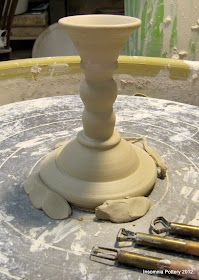Here's a nice stem ready for trimming. I have several small Dolan trim tools that make this easy. The base of the stem is still massive and solid, and I like to detail the stem before hollowing out the base,
I've gone to some pains to keep the small cup at the top moist since most of the problems I've had in the past have to do with two two segments not joining up properly.
Here's that same base with some trimmed details. If your stem is not centered carefully, it's hard to get nice results. You can see the little Dolan trim tools in the photograph.
Just as soon as I get it shaped, I moisten the interior surface of the upper cup with a wet finger, and stick a piece plastic over it.

Here's another nice stem ready to use. I will probably do just a bit of carving on some of the elements of the stem.
Now, it's time to trim out the foot.
I attach the vase that I made with the goblet components to the wheelhead. This is a carefully thrown sacrificial piece that will be used as a chuck to trim the bases of the stems.
I want it to be quite moist, so the stem will stick to it during the trimming process. I adhere the chuck to the wheel securely with fat coils of clay.
When you make your chuck, take care to make the top opening wide enough to accommodate the top of your stem.
A chuck like this can be use to trim bottles, small ewers, and many other pieces that are fragile or difficult to trim.
When the stem is well centered in the chuck, you can begin to trim. I use the same small tools to hollow out the foot.
You can see how crude the base of the foot is when trimming begins.
I like to trim the out portion of the foot very carefully, so the goblet will sit flat. It takes some concentration for me to hollow the foot. I almost always feel that trimming takes much more attention than throwing, but that is probably different for each potter.
 You can see that the trimming begun. There's a lot of torque on the base as you trim, so moderate your wheel speed carefully.
You can see that the trimming begun. There's a lot of torque on the base as you trim, so moderate your wheel speed carefully. Here's a finished stem ready to use. There is nice form detail on the stem, and the the base is appropriately sectioned for drying.
Now, for the joining.
With the cup portion of the goblet attached to wheelhead, score its' base and also score the interior of the cup at the top of your stem.
I like to add a blob of nice thick slip to fill any voids in the space that might be created.
Position the stem upside down on the base and turn the wheel slowly. You will be able to see if the stem is correctly positioned. If it is plumb and centered there will be no wobble at all if the wheel turns.
You will have a little time to adjust the position - the slip helps with that.
Here are my stems and cups, all put together. I will dry them upside down for a couple of hours before turning them over; being careful not to let them get too dry for some surface decoration.
Here are some finished goblets and chalices. The chalices were thrown in one piece.















